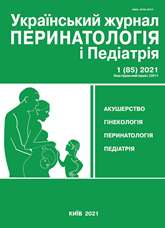Features of sexual development in girls with general and genital infantilism in the early reproductive period
DOI:
https://doi.org/10.15574/PP.2021.85.17Keywords:
general infantilism, genital infantilism, hypogonadotropic hypogonadism, normogonadotropic hypogonadism, hypergonadotropic hypogonadism, hirsutismAbstract
Purpose — study of the severity of secondary sexual characteristics in girls with general and genital infantilism in the early reproductive period.
Materials and methods. 150 girls with general and genital infantilism were examined. All examined girls underwent clinical, functional, hormonal, biochemical, radiological, genetic and laboratory tests. The average age of girls was 19.56±0.13 (17–22) years. The average weight of the examined was within 55.37±1.56 (32–98) kg, height 1.57±0.13 (1.36–1.71) m. The body-mass index was 22.5±0.48 (15–48). The severity of secondary sexual characteristics was
assessed according the J. Tanner scale.
Results and conclusions. It was found that adolescents with general infantilism (hypogonadotropic hypogonadism) have a significant delay in the development of secondary sexual characteristics against the background of mild hirsutism (р<0.05). In Patients with genital infantilism (hypergonadotropic hypogonadism), significant axillary and suprapubic hair growth at the background of poor development of the mammary glands was noted. Also the moderate degree of hirsutism was confirmed. With normogonadotropic hypogonadism, the development of secondary sexual characteristics corresponds to similar indicators of practically healthy girls.
The research was carried out in accordance with the principles of the Helsinki Declaration. The study protocol was approved by the Local Ethics Committee of these Institutes. The informed consent of the patient was obtained for conducting the studies.
The authors declare no conflicts of interests.
References
Bozzola M, Bozzola E, Montalbano C, Stamati FA. (2018). Delayed puberty versus hypogonadism: a challenge for the pediatrician. Annals of Pediatric Endocrinology and Metabolism. 23: 57-61. https://doi.org/10.6065/apem.2018.23.2.57; PMid:29969875 PMCid:PMC6057016
Charania JS, Salaskar VV. (2014). Disorder of sexual development in menstrual dysfunction. J Obstet Gynaecol India. 63 (3): 190-195. https://doi.org/10.1007/s13224-012-0303-0; PMid:24431636 PMCid:PMC3696142
Dankova IV, Goncharova SV. (2013). Prognozirovanie reproduktivnogo potentsiala u devochek, rodivshihsya s zaderzhkoy vnutriutrobnogo razvitiya. Reproduktivnoe zdorove detey i podrostkov. 5: 32–39.
Əkbərli KR, Əliyeva EM, Qaraşova MA. (2014). Erkən reproduktiv dövrdə amenoreyalı qızlarda cinsi inkişafın xüsusiyyətləri. Azərbaycan təbabətin müasir nailiyyətləri. 3: 203 206.
Fatalieva LM, Alieva EM. (2005). Osobennosti fizicheskogo i polovogo razvitiya devochek v periode polovogo razvitiya v usloviyah g. Baku. J. Sağlamlıq. 7: 14–17.
Filatova OV, Harchenko EV. (2015). Osobennosti vzaimosvyazi parametrov fizicheskogo i polovogo razvitiya podrostkov Barnaula. Acta Biologica Sibirica. 3 4: 7–23.
Mustafayeva İR, Əliyeva EM, Səfərəliyeva AR, Poladova NM. (2008). Naxçıvan şəhəri şəraitində cinsi yetişkənlik dövründə 16 17 yaşlı qızlarda II-li cinsi əlamətlərin formalaşmasının və ultrasəs müayinəsinin xüsusiyyətləri. 4: 41–44.
Nadzhi LA, Alieva EM, Efendieva AG. (2010). Osobennosti razvitiya vtorichnyih polovyih priznakov i stanovleniya menstrualnoy funktsii devochek v dinamike perioda polovogo sozrevaniya. Salamlyig. 7: 68-73.
Palmert MR, Dunkel L. (2012). Clinical practice. Delayed puberty. N Engl J Med. 366: 443-453. https://doi.org/10.1056/NEJMcp1109290; PMid:22296078
Puzikova OZ, Moskovkina AV, Bezhenar VF. (2018). Sindrom giperandrogenii u devochek-podrostkov: osobennosti klinicheskih proyavleniy i ranney diagnostiki. Pediatriya. Zhurnal im GN Speranskogo. 97 (6): 187-191. https://doi.org/10.24110/0031-403X-2018-97-6-187-191
Rusyn LP, Malyar VA, Malyar V. (2014). Reproductive health in adolescent girls in puberty, born with underweight. Lik Sprava. 12: 65–68.
Zhukovets IV, Byistritskaya TS. (2012). Osobennosti formirovaniya reproduktivnoy sistemyi u devochek s disfunktsiey gipotalamusa. Doktor Ru. 1 (69): 52–55.
Downloads
Published
Issue
Section
License
The policy of the Journal “Ukrainian Journal of Perinatology and Pediatrics” is compatible with the vast majority of funders' of open access and self-archiving policies. The journal provides immediate open access route being convinced that everyone – not only scientists - can benefit from research results, and publishes articles exclusively under open access distribution, with a Creative Commons Attribution-Noncommercial 4.0 international license(СС BY-NC).
Authors transfer the copyright to the Journal “MODERN PEDIATRICS. UKRAINE” when the manuscript is accepted for publication. Authors declare that this manuscript has not been published nor is under simultaneous consideration for publication elsewhere. After publication, the articles become freely available on-line to the public.
Readers have the right to use, distribute, and reproduce articles in any medium, provided the articles and the journal are properly cited.
The use of published materials for commercial purposes is strongly prohibited.

